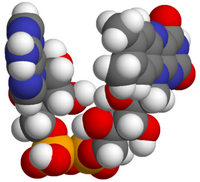
Photo from wikipedia
It is well-known that the ratio of reduced l-glutathione (GSH) to oxidized l-glutathione (GSSG) is a vital biomarker for monitoring overall cellular health, thus detecting the intracellular concentration of glutathione… Click to show full abstract
It is well-known that the ratio of reduced l-glutathione (GSH) to oxidized l-glutathione (GSSG) is a vital biomarker for monitoring overall cellular health, thus detecting the intracellular concentration of glutathione is of great significance. Recently, an increasing number of reports have published various methods for GSH detection, but studies on the detection of GSSG are still rare. Here, we report a kind of new yellow fluorescent carbon dots (CDs) for the detection of GSSG through a fluorescence "off-on" process. Because the surface is rich in amino groups, the CDs show a positive potential. When the concentration of GSSG was continuously increased, the CDs' fluorescence dropped sharply, while the fluorescence gradually recovered after the addition of sodium sulfide. The phenomenon of fluorescence quenching is linear with the concentration of the quencher (GSSG)(0-200 μM), and 0.18 μM is calculated as the detection limit. More interestingly, as a fluorescent probe, the CDs can be further used for fluorescence imaging in living cells and zebrafish.
Journal Title: ACS applied materials & interfaces
Year Published: 2022
Link to full text (if available)
Share on Social Media: Sign Up to like & get
recommendations!